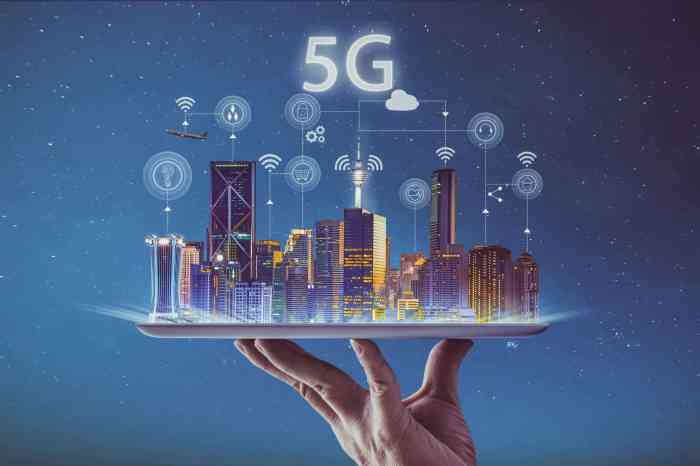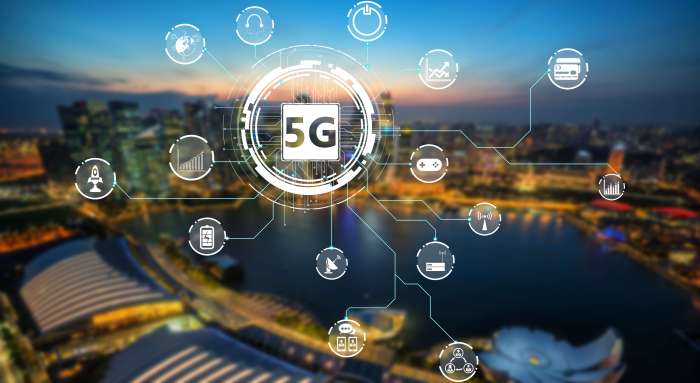5G Technology sets the stage for this enthralling narrative, offering readers a glimpse into a story that is rich in detail and brimming with originality from the outset. It’s not just about faster internet; it’s about a paradigm shift in how we connect, communicate, and interact with the world around us.
5G is the latest generation of cellular technology, building upon the foundations laid by its predecessors – 1G, 2G, 3G, and 4G – to deliver unparalleled speed, low latency, and massive capacity.
This transformative technology is poised to revolutionize industries and reshape our daily lives. From enabling seamless mobile broadband and internet access to powering innovative applications in healthcare, manufacturing, and transportation, 5G is unlocking a world of possibilities. This exploration will delve into the technical intricacies of 5G, examine its benefits and applications, and address the challenges and opportunities that lie ahead.
Introduction to 5G Technology

The fifth generation of wireless cellular technology, 5G, represents a significant leap forward in mobile communication, building upon the legacy of its predecessors. It promises significantly faster speeds, lower latency, and greater capacity, paving the way for a new era of connected devices and services.
Evolution of Cellular Technology
Cellular technology has undergone a continuous evolution, with each generation introducing new capabilities and advancements.
- 1G (1980s):The first generation of cellular technology, primarily focused on voice communication, used analog signals and had limited data capabilities.
- 2G (1990s):The second generation introduced digital signals, paving the way for text messaging and improved voice quality. GSM and CDMA were prominent 2G standards.
- 3G (2000s):Third generation cellular technology brought about faster data speeds, enabling mobile internet access and multimedia applications. Standards like UMTS and EV-DO became popular.
- 4G (2010s):The fourth generation introduced high-speed mobile broadband, enabling streaming video, online gaming, and other data-intensive applications. LTE and WiMAX were key 4G technologies.
- 5G (2020s):The fifth generation represents a significant leap forward, offering significantly faster speeds, lower latency, and greater capacity, enabling new use cases like autonomous vehicles, remote surgery, and the Internet of Things.
Key Features and Advancements of 5G Technology
G technology introduces several key advancements compared to previous generations:
- Higher Data Rates:5G offers significantly faster download and upload speeds, ranging from 100 Mbps to several Gbps, enabling seamless streaming of high-definition video, lightning-fast downloads, and more responsive online experiences.
- Lower Latency:5G reduces the delay between sending and receiving data, known as latency. This improvement is crucial for real-time applications like online gaming, virtual reality, and autonomous driving, where quick responses are essential.
- Increased Capacity:5G technology can support a much higher density of connected devices in a given area, making it ideal for scenarios like large-scale events, smart cities, and the Internet of Things, where numerous devices require connectivity.
- Enhanced Reliability:5G networks are designed for greater reliability, ensuring consistent and uninterrupted connectivity, which is essential for critical applications like emergency services, industrial automation, and remote healthcare.
- Improved Energy Efficiency:5G technology incorporates energy-saving features, reducing power consumption for both devices and network infrastructure, promoting sustainability and extending battery life.
Frequency Bands and Spectrum
G networks utilize various frequency bands, each with its own characteristics and advantages:
- Low-Band (Sub-6 GHz):These frequencies offer longer range and better penetration through walls and obstacles, making them suitable for wide-area coverage. Examples include 600 MHz and 850 MHz.
- Mid-Band (2-6 GHz):These frequencies provide a balance between range and capacity, making them ideal for urban areas and dense environments. Examples include 2.5 GHz and 3.5 GHz.
- High-Band (above 24 GHz):These frequencies offer the highest data rates and lowest latency but have shorter ranges and are more susceptible to blockage. Examples include 28 GHz and 39 GHz.
Technical Aspects of 5G
G technology is built upon a complex and sophisticated network infrastructure, employing a range of advanced technologies to deliver its promised high-speed data rates, low latency, and massive connectivity. Understanding the technical aspects of 5G is crucial for comprehending its capabilities and limitations.
5G Network Architectures
G network architectures are designed to cater to the diverse needs of various applications and user scenarios. Two primary architectures are employed: Non-Standalone (NSA) and Standalone (SA).
- Non-Standalone (NSA): This architecture leverages existing 4G LTE infrastructure (Evolved Packet Core, EPC) for core network functions while utilizing new 5G radio access technology (NR). NSA provides a gradual transition path to 5G, enabling operators to deploy 5G services without completely overhauling their existing infrastructure.
However, it relies on the availability of 4G LTE networks and may not offer the full potential of 5G capabilities.
- Standalone (SA): This architecture represents a complete shift to 5G, employing a dedicated 5G core network (5GC) and radio access network (RAN). SA provides the full suite of 5G features, including enhanced security, network slicing, and edge computing, but requires a more significant investment in infrastructure.
5G Network Components
The 5G network is composed of three primary components: the core network, the radio access network (RAN), and the user equipment (UE).
- 5G Core Network (5GC): The 5GC is the brain of the 5G network, responsible for managing user sessions, controlling network resources, and providing core network services. It handles data routing, authentication, and other essential functions, enabling seamless communication between devices and applications.
- Radio Access Network (RAN): The RAN connects user equipment to the 5GC, providing the wireless interface for data transmission. It consists of base stations, antennas, and other radio equipment responsible for signal processing and transmission. The RAN is the crucial component responsible for delivering high-speed data rates and low latency.
- User Equipment (UE): This refers to any device that connects to the 5G network, such as smartphones, tablets, laptops, and IoT devices. The UE interacts with the RAN through the radio interface, receiving and transmitting data to the 5GC.
Key Technologies Enabling 5G
Several key technologies contribute to the performance and capabilities of 5G, including:
- Massive MIMO (Multiple-Input Multiple-Output): This technology utilizes multiple antennas at both the base station and the user device to transmit and receive data simultaneously. Massive MIMO enhances data throughput, improves coverage, and reduces interference, leading to a more efficient and reliable network.
- Beamforming: Beamforming focuses radio signals towards specific user devices, minimizing interference and improving signal strength. This technology allows for more efficient use of radio spectrum and enhances data rates for individual users.
- OFDM (Orthogonal Frequency Division Multiplexing): OFDM divides the available bandwidth into multiple sub-carriers, allowing for more efficient use of spectrum and improved resistance to interference. It also enables flexible data transmission rates and accommodates diverse user requirements.
Technical Specifications of 5G
The following table summarizes the key technical specifications of 5G compared to previous generations:
| Specification | 1G | 2G | 3G | 4G | 5G |
|---|---|---|---|---|---|
| Data Rate (peak) | 2.4 kbps | 9.6 kbps | 384 kbps | 100 Mbps | 20 Gbps |
| Latency | 100 ms | 50 ms | 30 ms | 5 ms | 1 ms |
| Frequency Bands | 800 MHz | 900 MHz, 1800 MHz | 1900 MHz, 2100 MHz | 700 MHz, 1800 MHz, 2100 MHz | 6 GHz, 24 GHz, 28 GHz, 39 GHz, 60 GHz |
| Network Architecture | Analog | Digital | Digital | Digital | Digital |
| Key Technologies | Analog modulation | TDMA, FDMA | CDMA, TD-SCDMA, WCDMA | OFDM, MIMO | Massive MIMO, Beamforming, OFDM, Network Slicing, Edge Computing |
Deployment and Challenges of 5G: 5G Technology

The deployment of 5G networks is progressing globally, with many countries having launched commercial services. However, various challenges and obstacles hinder the widespread adoption of this transformative technology.
Spectrum Allocation and Regulatory Issues
Spectrum allocation is a crucial factor in 5G deployment, as it determines the frequency bands available for network operation. The availability and accessibility of suitable spectrum bands vary across different regions. Regulatory bodies play a vital role in managing spectrum resources, ensuring efficient allocation and minimizing interference.
- Frequency Bands:5G networks typically operate in higher frequency bands (above 24 GHz), which offer higher bandwidth but have limited range and are susceptible to signal attenuation. However, these bands are often already allocated to other services, requiring careful planning and coordination to ensure seamless integration.
- Spectrum Auctions:Governments often conduct spectrum auctions to allocate valuable frequency bands to mobile operators. These auctions can be expensive, requiring substantial investments from operators, which may impact the affordability of 5G services.
- International Coordination:Global harmonization of spectrum bands is crucial to ensure seamless roaming and interoperability across borders. This requires international collaboration and agreement among regulatory authorities to establish consistent spectrum allocation policies.
Infrastructure Development and Costs
The deployment of 5G networks requires extensive infrastructure development, including the installation of new base stations, fiber optic cables, and data centers. This infrastructure investment can be substantial, posing a significant challenge for operators, especially in developing countries.
- Base Station Deployment:5G base stations are denser than previous generations, requiring a significant increase in the number of installations. This poses logistical challenges, including finding suitable locations, obtaining permits, and coordinating with local authorities.
- Fiber Optic Network Expansion:5G networks rely heavily on fiber optic cables to handle the high data volumes. Expanding fiber optic infrastructure to reach remote areas can be costly and time-consuming.
- Data Center Capacity:5G networks generate massive amounts of data, requiring robust data center infrastructure to process and store this information. Building and maintaining data centers is a substantial capital investment, particularly in terms of power consumption and cooling requirements.
Security and Privacy Concerns
The increased connectivity and data volumes associated with 5G raise concerns about security and privacy. Ensuring the integrity and confidentiality of data transmitted over 5G networks is paramount, particularly in light of potential vulnerabilities to cyberattacks and data breaches.
- Network Security:5G networks are complex and interconnected, making them susceptible to various security threats. Implementing robust security measures, including encryption and authentication protocols, is crucial to protect network infrastructure and user data.
- Data Privacy:The vast amounts of data generated by 5G networks raise concerns about user privacy. Strong data privacy regulations and responsible data management practices are essential to protect user information from unauthorized access or misuse.
- Potential for Misuse:5G technology can be used for both legitimate and illegitimate purposes. It is important to address potential security risks and ensure that 5G is used ethically and responsibly.
Public Perception and Adoption
Public perception and understanding of 5G technology are crucial factors influencing adoption rates. Misinformation and concerns about potential health risks can hinder public acceptance.
- Health Concerns:Some individuals express concerns about the potential health effects of radiofrequency electromagnetic fields emitted by 5G base stations. While scientific evidence suggests these emissions are safe at current levels, it is important to address these concerns through public education and transparency.
- Lack of Awareness:Many people may not fully understand the benefits and potential of 5G technology. Raising awareness and educating the public about 5G’s capabilities can encourage adoption.
- Cost of Devices and Services:5G-enabled devices and services can be expensive, potentially limiting adoption, particularly in developing countries. Making 5G more affordable and accessible to a wider audience is crucial for widespread adoption.
Future of 5G and Beyond
The future of 5G is bright, with ongoing advancements and the emergence of new technologies like 6G promising to revolutionize communication and connectivity. 5G is not just a stepping stone but a platform for innovation, paving the way for a more connected and intelligent world.
Advancements in 5G Technology
G technology is constantly evolving, with researchers and engineers working on enhancing its capabilities and addressing its limitations.
- Enhanced Mobile Broadband (eMBB):Continued development in eMBB will focus on increasing data rates and capacity, enabling seamless streaming of high-definition video, immersive gaming, and other bandwidth-intensive applications.
- Ultra-Reliable Low Latency Communication (URLLC):Improvements in URLLC will target critical applications like autonomous vehicles, industrial automation, and remote surgery, where reliability and low latency are paramount. This will involve optimizing network architecture and developing advanced algorithms for real-time communication.
- Massive Machine-Type Communication (mMTC):mMTC is expected to play a crucial role in the Internet of Things (IoT), enabling the connection of billions of devices. Advancements in mMTC will focus on managing large-scale deployments, optimizing power consumption, and enhancing security for connected devices.
- Network Slicing:5G network slicing allows for the creation of virtual networks tailored to specific applications. This technology will continue to evolve, enabling more efficient resource allocation and customized network performance for different use cases.
- Artificial Intelligence (AI):AI is playing an increasingly important role in optimizing 5G networks, enhancing performance, and automating network management tasks. Future advancements will focus on leveraging AI for network optimization, predictive maintenance, and fraud detection.
Emergence of 6G
While 5G is still in its early stages of deployment, research and development for the next generation of wireless technology, 6G, is already underway. 6G is expected to offer significantly enhanced capabilities, including:
- Higher Data Rates:6G is anticipated to achieve data rates up to 100 times faster than 5G, enabling seamless transmission of massive amounts of data.
- Ultra-Low Latency:6G will push latency down to the millisecond range, opening up new possibilities for real-time applications and edge computing.
- Enhanced Security:6G will prioritize security, incorporating advanced encryption techniques and robust authentication protocols to protect sensitive data.
- Increased Capacity:6G is expected to handle a significantly higher number of connected devices, supporting the massive growth of the IoT.
- New Frequency Bands:6G is likely to utilize higher frequency bands, such as the terahertz spectrum, offering wider bandwidth and faster speeds.
Impact of 5G on Industries
G is transforming industries across the globe, enabling new business models, enhancing productivity, and creating new opportunities.
- Manufacturing:5G is enabling the development of smart factories, where machines and robots communicate in real-time, optimizing production processes and reducing downtime.
- Healthcare:5G is facilitating remote surgery, telemedicine, and personalized healthcare by enabling high-bandwidth, low-latency communication between doctors and patients.
- Transportation:5G is playing a crucial role in the development of autonomous vehicles, smart traffic management systems, and connected transportation networks.
- Energy:5G is enabling the creation of smart grids, where energy generation, distribution, and consumption are optimized in real-time, improving efficiency and reliability.
- Finance:5G is enabling secure and efficient financial transactions, facilitating mobile payments, and supporting innovative financial services.
Role of 5G in Shaping the Future of Communication and Connectivity
G is fundamentally changing the way we communicate and connect with the world around us. It is paving the way for:
- Ubiquitous Connectivity:5G is expanding the reach of wireless connectivity, bringing high-speed internet access to more people and places.
- Immersive Experiences:5G is enabling immersive experiences, such as virtual reality (VR) and augmented reality (AR), providing users with more realistic and engaging interactions.
- Intelligent Automation:5G is driving the adoption of AI and automation, enabling smarter and more efficient systems in various industries.
- Enhanced Collaboration:5G is facilitating seamless collaboration between individuals and teams, regardless of location, through real-time communication and data sharing.
- New Business Models:5G is creating opportunities for new business models, driven by data analytics, AI, and the interconnectedness of devices.
Conclusive Thoughts
As we stand on the cusp of a new era defined by 5G, it’s clear that this technology is more than just a faster internet connection. It’s a catalyst for innovation, a driver of economic growth, and a force that will shape the future of our connected world.
From the seamless integration of smart devices and autonomous vehicles to the delivery of life-saving medical treatments, 5G is poised to redefine how we live, work, and interact with the world around us. The journey into the 5G era is just beginning, and the possibilities are truly boundless.
Commonly Asked Questions
What are the key differences between 5G and previous generations of cellular technology?
5G offers significantly faster speeds, lower latency, and greater capacity compared to its predecessors. It utilizes new spectrum bands and advanced technologies like Massive MIMO and beamforming to achieve these advancements.
Is 5G safe for human health?
Extensive research and studies have shown that 5G operates within safe levels of electromagnetic radiation. The World Health Organization (WHO) has stated that the radio waves used by 5G are not harmful to human health.
How can I access 5G networks?
To access 5G networks, you need a compatible 5G-enabled device and a service plan that includes 5G coverage from your mobile carrier. Check with your carrier for availability in your area.
